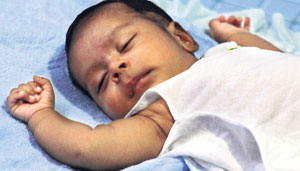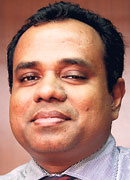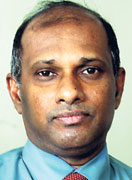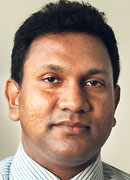Thank you.
These two simple words hardly seem adequate to the overwhelming response from you our dear readers to the appeal by the Sunday Times to help save the life of “our baby”, yours and ours.
Yes, you adopted the ‘Bubble Baby of Sri Lanka’, rallied round Sanjana Praveen Shivanka and let the donations flow in, to enable his parents K.B.N. Damayanthi and K.W. Neil Anura Shantha of Dippitigala, Lellopitiya in Ratnapura to take him to the Apollo Hospital in Chennai for that life-saving bone marrow transplantation.
 |
The collection as of Friday, August 27 was Rs. 3,981,980.
From the humble coins that children at an international school dropped into an empty ice-cream container to the simple Rs. 100 that someone took the trouble to deposit at the bank to numerous thousands that a majority gave, some even sending their cheques to the Sunday Times offices and the largesse ranging from Rs. 75,000 to Rs. 500,000 that a few transferred direct from their accounts, the response left us with a renewed faith in humankind. Each and everyone gave silently, adamantly refusing any kind of publicity. Not only donations but also queries about “our baby” came from all corners of the country and as far away as America and Australia, indicating that Sri Lankans do care.
As his parents and doctors joined the Sunday Times to let you know how appreciative we are of your efforts, frantic preparations are underway to fly baby Shivanka to Chennai.
In addition to you our readers who came forward to try and change the destiny of baby Shivanka those who have played a crucial role in his life, which has not yet reached the two-month milestone, are: Medical Geneticist Dr. Vajira H.W. Dissanayake, Medical Officer Dr. Jagathie Fonseka and Genetic Nurse P.K.D.S. Nisansala of the Human Genetics Unit and Clinical Haematologist Dr. Lallindra Gooneratne all of the Colombo Medical Faculty; Clinical Immunologist Dr. Rajiva de Silva of the Medical Research Institute; and Consultant Obstetrician and Gynaecologist Dr. Athula Kaluarachchi and his team of doctors and nurses and Consultant Paediatrician Dr. Samanmalee Sumanasena and her team of doctors of the Professorial Unit of the De Soysa Women’s Hospital.
Baby Shivanka is suffering from the rare genetic disease, Severe Combined Immuno-deficiency (SCID), in which his immune system’s cells are affected. This makes him extremely vulnerable to life-threatening infectious diseases spread by viruses, bacteria and fungi.
 |
 |
| Dr.Dissanayake |
Dr. de Silva |
The immune system is made up of a network of cells, tissues and organs. The cells are white blood cells or leukocytes which come in two basic types that combine to seek out and destroy disease-causing organisms or substances. Leukocytes are produced or stored in many locations in the body, including the bone marrow and circulate between the organs and lymph nodes via lymphatic and blood vessels, monitoring germs or substances that might cause problems.
Leukocytes can be grouped into phagocytes that chew up invading organisms and lymphocytes that allow the body to remember and recognize previous invaders and help destroy them.
While neutrophils are the most common type of phagocyte and primarily fight bacteria, there are two kinds of lymphocytes -- B and T. Lymphocytes start out in the bone marrow and either stay there and mature into B cells or leave for the thymus gland, where they mature into T cells. B cells are like the body's military intelligence system, seeking out targets and sending defences to lock onto them while T cells are like soldiers, destroying the invaders that the intelligence system has identified.
In around 50% of those suffering from SCID where T-cells and B-cells are both severely dysfunctional, the disease has been caused by a mutation in an X-chromosome gene, usually passed down by the mother. The mother has two X chromosomes and the father an X and a Y chromosome and depending on the combination of the chromosomes in the baby, boys succumb to SCID while the girls are carriers of the disease.
The answer, of course, is a bone marrow transplant (see box) which thanks to you, baby Shivanka will undergo next month.
So, from the bottom of our hearts, we at the Sunday Times say a big thank you.
What happens now?
When baby Shivanka arrives at the Apollo Hospital in Chennai he will undergo a detailed clinical assessment and a course of injections administered to destroy the diseased cells of his immune system which are found in the bone marrow or the soft, spongy, fatty tissue inside his bones.
Bone marrow found in the hip and thigh bones contains immature cells called stem cells (precursors) which develop into red blood cells which carry oxygen to tissues, white blood cells which fight infection and platelets which help in blood clotting.
"This preparative regimen which will consist of some chemotherapeutic agents will take about a week to administer," said Clinical Haematologist Dr. Lallindra Gooneratne, explaining that this is referred to as "conditioning" by which the baby's bone marrow cells are destroyed to make room for the donor's cells to be transplanted.
 |
| Dr.Gooneratne |
As the conditioning also destroys healthy cells in other parts of the body there could be many side-effects and the baby becomes prone to infections. Therefore, he will be kept in total isolation in a special room fitted with filters to keep the environment clean, the Sunday Times understands.
Next he will be administered cord blood cells which have stem cells from a compatible donor.
Once the cord blood cells are administered to baby Shivanka through a catheter or a narrow flexible tube, like a drip, into a large vein in the chest, they will migrate from the blood stream to the cavities within the bones and start forming new bone marrow cells. If the transplant is successful, the bone marrow will produce normal blood cells, Dr. Gooneratne said.
A donor is needed because his bone marrow does not match either that of his father or mother, said Medical Geneticist Dr. Vajira Dissanayake.
The success of a stem cell transplantation "engraftment" will be determined only after two to three weeks, when his blood counts start normalizing, says Dr. Gooneratne, adding that the baby may have to be given antibiotics and blood and platelet transfusions to help fight infection and prevent excessive bleeding during this crucial period.
Transplants can be accompanied by a risk of infection, transplant rejection by the recipient's immune system and other complications such as graft - versus- host disease, he says, adding that there could be a significant risk to life as well. |





